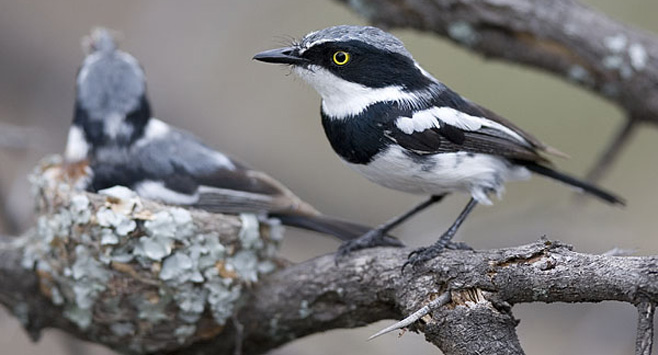|
Batis molitor (Chinspot
batis)
Witliesbosbontrokkie [Afrikaans]; Undyola, Unondyola
[Xhosa]; umNqube [Zulu]; Ximgenngwamangwami [Tsonga]; Witflank-vliegenvanger
[Dutch]; Pririt molitor [French]; Weißflankenschnäpper [German]; Batis-comum
[Portuguese]
Life
> Eukaryotes >
Opisthokonta
> Metazoa (animals) >
Bilateria >
Deuterostomia > Chordata >
Craniata > Vertebrata (vertebrates) > Gnathostomata (jawed
vertebrates) > Teleostomi (teleost fish) > Osteichthyes (bony fish) > Class:
Sarcopterygii (lobe-finned
fish) > Stegocephalia (terrestrial
vertebrates) > Tetrapoda
(four-legged vertebrates) > Reptiliomorpha > Amniota >
Reptilia (reptiles) >
Romeriida > Diapsida > Archosauromorpha > Archosauria >
Dinosauria
(dinosaurs) > Saurischia > Theropoda (bipedal predatory dinosaurs) >
Coelurosauria > Maniraptora > Aves
(birds) >
Order: Passeriformes
> Family: Malaconotidae
Distribution and habitat
Common across Africa south of the Sahel, from Angola
and the DRC to southern Africa. Here it is prolific, occurring in large areas of
Zimbabwe, Botswana, Mozambique, north-central Namibia, Limpopo Province,
KwaZulu-Natal and the Eastern Cape. It generally prefers savanna woodland,
especially when it is dominated by Acacia, miombo (Brachystegia)
or Mopane (Colosphermum mopane) trees. It also occupies valley bushveld,
but it is rare in alien vegetation and evergeen forest.
|
 |
|
Distribution of Chinspot batis in southern Africa,
based on statistical smoothing of the records from first SA Bird Atlas
Project (©
Animal Demography unit, University of
Cape Town; smoothing by Birgit Erni and Francesca Little). Colours range
from dark blue (most common) through to yellow (least common).
See here for the latest distribution
from the SABAP2. |
Predators and parasites
Nestlings have been recorded as prey of
Accipiter badius (Shikra).
Brood parasites
It has been recorded as host of the
Klaas's cuckoo.
Food
It exclusively eats insects, doing most of its foraging in
the tree canopy, gleaning prey off leaves and branches. The following food items
have been recorded in its diet:
Breeding
- Both sexes build the nest (see image below), which is a small cup made of shredded plant
material such as grass stems and bark, bound together with strands of spider
web. It is usually placed on a tree branch, often between the stems of a
fork.
 |
|
Chinspot batis female (left) and male (right) at
nest, Nylstroom, South Africa. [photo
Johann Grobbelaar
©] |
- Egg-laying season is from August-February, peaking from about
September-December.
- It lays 1-4, usually 2 eggs, which are incubated solely by the female
for about 16-18 days. The female sometimes leaves the nest to forage, but
most of her food is brought to her by the male.
- The chicks are cared for by both parents, leaving the nest at about
16-18 days old, becoming independent about 6-14 weeks later.
Threats
Not threatened.
References
-
Hockey PAR, Dean WRJ and Ryan PG 2005. Roberts
- Birds of southern Africa, VIIth ed. The Trustees of the John Voelcker
Bird Book Fund, Cape Town.
|
